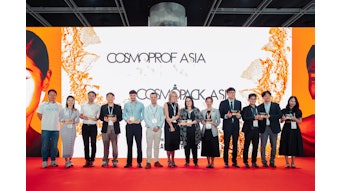The grey clouds draped across Boston skies did not stop formulators from shining at center stage with novel concepts in cosmetics and personal care. The SCC Annual Scientific Seminar, held May 11-12, 2006, at the Boston Copely Marriott Place, enlightened attendees with innovations in claims support and hair formulations and delved into new areas like green chemistry, cosmetic dermatology and medical spas.
Session one, moderated by Mindy Goldstein, Ph.D. (Estée Lauder), highlighted cosmetic dermatology and medical spas—a more invasive area of emerging interest to cosmetic scientists. Zoe Diana Draelos, M.D. (Dermatology Consulting Services), discussed beauty treatments such as botulinum toxin injections, hyaluronic acid injectables, collagen injectables, fat transfer, microdermabrasion, superficial peels and medium depth peels.
A superficial, “lunchtime” facial peel, for example, is a chemical disruption of the corneocytes, whereas microdermabrasion is a mechanical disruption. She described the importance of having a licensed professional perform these procedures, as variables including the orientation of facial muscles and ethnic pigmentation must be taken into account when treating patients. Medium-depth chemical peels, Draelos said, are designed to “wound” the skin, which activates melanocytes in darker-skinned individuals and can cause discoloration.
According to Draelos, fillers are replacing nips and tucks as the future of cosmetic dermatology. “Fillers replace what has been lost from the skin and replace facial proportions,” said Draelos. “You not longer want to cut away excess skin, but replace the missing fat from under the skin.” She added that 20 varieties of hyaluronic acid are coming out and speculated that fillers as an area to watch.
Following Draelos’s report on cosmetic dermatology, Eric F. Bernstein, M.D. (University of Pennsylvania), discussed laser therapy for removing tattoos and hair and treating acne, scars and skin conditions including rosacea. Many factors are involved with choosing the appropriate laser as well as practitioner to treat the condition, but a key concept Bernstein conveyed was: “Don’t think like a physicist—think like a biologist.”
Andrew F. Alexis, M.D. (Saint Luke’s Roosevelt Hospital), discussed considerations in the treatment of ethnic skin, especially conditions such as keloid formation, follicular disorders such as razor bumps and acne. “The most common condition to treat in ethnic skin is acne,” said Alexis. He stressed the importance of collaborations between cosmetic scientists and dermatologists to find better treatments for ethnic skin.
The afternoon sessions ran concurrently and covered claims support and hair. Janusz Jachowicz, Ph.D. (International Specialty Products), moderated the claims support session, covering indentometric measurement of the skin, the use of digital photography and image analysis techniques to assess stratum corneum (SC) compromise in health care workers, nanohybrids for extraction and release of desirable attributes and for scavenging odors and toxic materials, and enhancing epidermal neuronal metabolism.
Vince Gruber, Ph.D. (Arch Personal Care), who presented on enhancing oxygen respiration in the skin, commented that “Fluorescence technology is allowing scientists to measure respiration (in the skin).” Pat Aikens (BASF) posed the question: “Does increasing the oxygen respiration in the skin increase free radicals?” To which Gruber replied, “Probably yes, it’s a law of nature.”
Moderator Colleen Rocafort (Ciba Specialty Chemicals) led the concurrent hair session, which looked into alternative dyeing processes and chemistries for hair, protecting relaxer actives by way of emulsion design, the effect of treatments on the shear modulus of the hair cortex and cuticle layer, and understanding the micro-physical and mechanical properties of hair cuticle via damage analysis.
Friday’s sessions on formulating and green chemistry were popular with attendees. The formulating session, moderated by Mark Chandler (Uniqema), investigated the effects of order of addition and interaction of polyelectrolyte-surfactant systems, a closer look at the salt curve and its link to rheology, structure and salt content in shampoos, and structure and rheology of viscoelastic micellar fluids in shampoo formulas. Srinivasa R. Raghavan, Ph.D. (University of Maryland), described a “self-assembly” approach to formulating in his well-presented talk describing “wormlike micelles.”
The session broke for an awards luncheon, honoring student posters. First place was awarded to Jessica Yuan, Micheline Samaan and E. Acosta (University of Toronto), for the poster entitled: “Linker-based Lecithin Microemulsions for Topical Delivery of Alpha-Tocopherol Acetate and Sodium Salicylate.” Smita Chawla, Marty Visscher, Ph.D., Randy Wickett, Ph.D., and Raymond Boissy, Ph.D. (University of Cincinnati), were awarded second place for: “On the Efficacy and Safety of a Novel Tyrosinase Inhibitor Deoxyarbutin, and its Second Generation Derivatives.” Third place was awarded for “Effect of Hydration on In-vitro Permeation of Antifungal Ketoconazole Through Human Nail Plate,” by Hemali Gunt and Gerald B. Kasting, Ph.D. (University of Cincinnati); and fourth place was presented to Tara Waller, Lisa R. Huisinga and Robert Y. Lochhead, Ph.D. (University of Southern Mississippi), for their poster entitled “Investigation of the Polyelectrolyte-association Colloid Interactions in the Semi-Dilute and Concentrated Regime Using High-Throughput Screening.”

(L to R) Yuan, Chawla, Don Katz (award sponsor from DD Chemco),
Gunt and Waller.
Rounding out the Annual Scientific Seminar, the session on green chemistry was moderated by Art Georgalas (TRI-K Industries), and featured concepts from a basic introduction to green chemistry and sustainable materials design and water-soluble crosslinking materials in cosmetics, to innovating in a resource-limited world and high performance products from renewable products. Amy S. Cannon (University of Massachusetts Lowell) stepped in for the introductory presenter and explained that the concept of green chemistry stemmed from the EPA. D. Tyler McQuade, Ph.D., (Cornell University), explained the concept of microreactors and encapsulated catalysts to cut down on processing steps while raising the efficiency of chemical synthesis. Attendees were very interested in learning ways to decrease processing costs and finding faster means to test and substantiate products and products claims.










